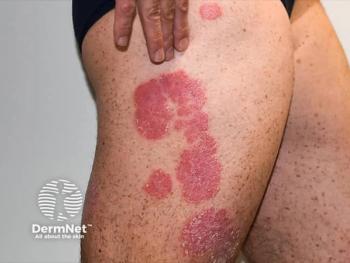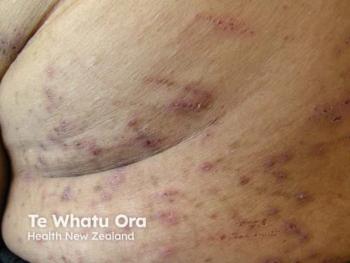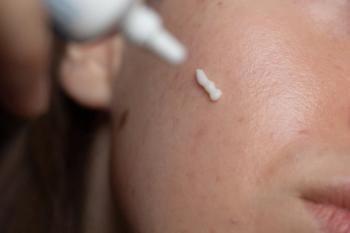
Psoriasis Linked to Sleep Disorders in Diverse Adults
Key Takeaways
- Psoriasis is linked to increased sleep disturbances, including restless legs syndrome, insomnia, and obstructive sleep apnea, especially in moderate to severe cases.
- Non-White psoriasis patients face higher risks of sleep disorders, indicating significant health disparities and the need for tailored interventions.
Psoriasis significantly impacts sleep health, with diverse populations facing increased risks of sleep disorders, highlighting urgent clinical needs for tailored interventions.
Psoriasis (PsO) is increasingly linked to various systemic comorbidities—including a range of sleep disorders. Mounting evidence suggests that individuals with PsO experience significantly more sleep-related disturbances compared to the general population.1 For instance, data from the National Health and Nutrition Examination Survey (NHANES) reveal that adults aged ≥20 years with PsO report greater trouble sleeping than their counterparts without the condition, even though objective sleep duration is often not significantly reduced.2 However, despite these emerging patterns, the relationship between PsO and sleep disturbances remains underexplored in large, diverse populations—particularly those accounting for sociodemographic differences and comorbid conditions.
Background
The lived experience of PsO is far from uniform. Disease severity, symptom burden (such as pruritus and pain), racial/ethnic identity, socioeconomic status, and co-occurring chronic diseases all shape how patients are affected by their condition, including its impact on sleep. Severe PsO—defined by criteria such as the “rule of 10s” or use of systemic therapies—is known to disrupt sleep more profoundly than mild cases, yet whether these disruptions meet diagnostic thresholds for disorders like insomnia or obstructive sleep apnoea (OSA) remains poorly characterized. Existing literature has often failed to account for this heterogeneity, limiting our understanding of which subgroups are most vulnerable and why.3
Methods
To address these gaps, researchers utilized the All of Us v7 database, which includes approximately 45% racial and ethnic minority participants, to investigate the relationship between PsO and specific sleep disorders.4 PsO diagnoses were identified via SNOMED-CT and ICD-10 codes, and severity stratified based on treatment history (e.g., biologics, phototherapy). A 1:4 matched case-control analysis controlled for sex, age, and race/ethnicity. They then assessed associations between PsO and 5 major sleep disorders: restless legs syndrome (RLS), insomnia, OSA, narcolepsy, and REM sleep behavior disorder (RBD), adjusting for relevant comorbidities and lifestyle factors.
Results
Among 7,473 adult PsO patients (mean age: 62.6 years; 57.4% women), 25% were categorized as having moderate to severe disease. Compared to matched controls, researchers stated patients with mild PsO had significantly higher odds of RLS (OR: 1.20), insomnia (OR: 1.48), and OSA (OR: 1.38), with even greater risks observed in the moderate to severe subgroup (RLS OR: 1.64; insomnia OR: 1.74; OSA OR: 1.81). No significant associations were found with narcolepsy or RBD. Notably, a subgroup analysis by race/ethnicity revealed that non-White patients consistently had higher odds of sleep disorders—especially insomnia and OSA—than White patients with PsO.
These findings echo prior research, such as a 2015 systematic review reporting elevated RLS and OSA prevalence among PsO patients, and a 2023 cross-sectional study linking Psoriasis Area Severity Index (PASI) scores to RLS severity. Furthermore, Egeberg et al.’s population-based Danish cohort similarly found increased OSA risk with escalating PsO severity, though they did not report data by race or ethnicity.
This analysis adds crucial nuance to the existing literature by evaluating PsO-related sleep disorders in a racially and socioeconomically diverse US cohort. Importantly, we demonstrate that non-White patients with PsO face disproportionate risks of sleep disturbances, raising concerns about compounded health inequities. These disparities may reflect differences in disease burden, access to care, underdiagnosis, or cultural attitudes toward sleep and symptom reporting.
Conclusion
Researchers stated recognizing and addressing the multifaceted relationship between PsO and sleep disorders—especially in vulnerable populations—must become a clinical priority. Tailored, culturally informed interventions that consider both dermatologic and sleep-related needs could significantly improve patient outcomes. However, they noted their findings should be interpreted in light of certain limitations, including reliance on electronic health records and the possibility of diagnostic misclassification. Future prospective studies with standardized diagnostic criteria and inclusion of underrepresented groups are essential to further elucidate these relationships.
Researchers concluded that psoriasis is more than a skin disease—it is a systemic condition with substantial impact on sleep health, particularly among patients with severe disease and those from historically marginalized backgrounds. They stated integrating dermatologic and sleep care within a framework of health equity may be key to improving quality of life for individuals living with PsO.
References
- Halioua B, Chelli C, Misery L, Taieb J, Taieb C. Sleep disorders and psoriasis: An update. Acta Derm Venereol. 2022;102:adv00699. Published 2022 Apr 27. doi:10.2340/actadv.v102.1991
- Smith P, Jin JQ, Spencer RK, et al. Psoriasis and sleep disturbance: A US population-based study using the NHANES database. Dermatol Ther (Heidelb). 2024;14(8):2277-2283. doi:10.1007/s13555-024-01211-2
- Abrouk M, Lee K, Brodsky M, et al. Ethnicity affects the presenting severity of psoriasis. J Am Acad Dermatol. 2017;77(1):180-182. doi:10.1016/j.jaad.2017.02.042
- Diaz MJ, Haq Z, Tran JT, et al. The association of psoriasis with sleep disorders in a diverse national cohort. JEADV Clinical Practice. 2025. doi: 10.1002/jvc2.70022.
Newsletter
Like what you’re reading? Subscribe to Dermatology Times for weekly updates on therapies, innovations, and real-world practice tips.


















